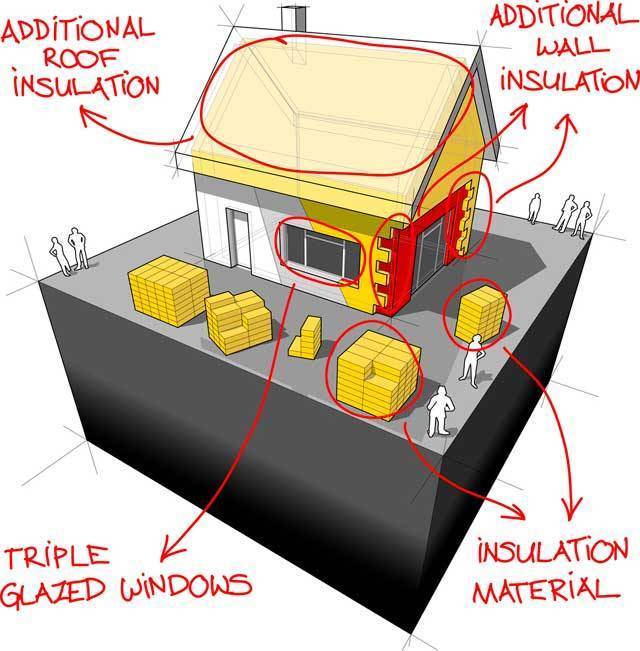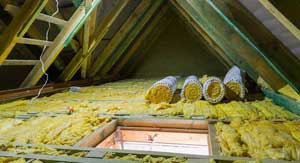A quarter of your heat escapes via the roof if you live in an uninsulated home. However, adding loft insulation or blown attic insulation to keep that heat in during the winter is a simple solution. With fuel prices at all-time highs, you don’t want to buy a drop more than you need, and loft insulation is all about reducing your heating fuel consumption.
There are a variety of loft insulation alternatives available, and depending on where you reside and other qualifying circumstances, you may be eligible for a government grant or significant tax credits for doing so.

Insulation works by allowing heat to naturally travel from a warmer to a cooler location. Because unheated garages, attics, and basements are naturally cooler in the winter, the heat from all your heated living rooms flows toward the outdoors and unheated garages, attics, and basements.
In the summer, the opposite happens: heat is transferred from the outside to the inside. Heat lost via the attic and walls of your home must be restored by your heating system to make your home pleasant, and the opposite is true during the summer.
Insulation in the walls, ceilings, and floors helps to trap heat in the house instead of leaking out via unheated regions. Insulation, in other words, prevents heat from escaping in the winter and returning in the summer.
In the United Kingdom, new residences must have 270 mm (10.5 inches) of insulation above the top storey ceilings. The question is whether 270 mm of one product will produce better outcomes than 270 mm of another. The 270 mm figure is based on fibreglass, which is the most affordable insulation material.
This amount of fibreglass insulation will cost around £5.30 per square metre, or $8.60 in US dollars. One issue with this thick of insulation is that most ceiling joists are just 100 mm deep, causing the insulation to protrude above the joists.
You can’t board up the insulation without removing the air gaps, which are what give fibreglass its insulating characteristics.
If you want thick loft insulation with boards flooring, you’ll need to either deepen the joists or lay the insulation between the rafters. For individuals who have battled with scratchy fibreglass insulation, there is now an enclosed version available, which is wrapped in a metalized polythene “space blanket” film that conceals the irritating surface. However, two 150 mm layers will be required, which will cost roughly £12, or $19.50 per square metre.
If you have the funds, polyisocyanurate (PIR), which is available in lightweight foam boards from businesses like Celotex, is the most efficient insulation material. Only 175 mm of PIR is needed to replace 270 mm of fibreglass, but it costs £21 ($34.00) per square metre. Furthermore, because it is hard, it must be properly cut to fit between the joists (or rafters).
Looking At More Eco Friendly Options
Some individuals are looking for environmentally friendly loft insulation, and sheep wool is one of those goods. It’s utilised to manufacture loft insulation rolls that are 20 percent more efficient than mineral wool fibre. This means you can replace 270 mm of fibreglass with 225 mm of wool.
It’s also non-irritating, and it’s reported to absorb moisture when it’s humid and release moisture when it’s dry, which can help keep a home or building’s temperature stable. However, at £20 ($32.50) per square metre, it is out of reach for many people, despite the fact that it lasts longer.
So, what are some of the benefits of adding loft insulation besides lowering your energy bills? For starters, consuming less heating fuel and energy reduces carbon dioxide emissions, which have been linked to climate change. You can keep 800 kg of carbon dioxide out of the air each year with excellent insulation.
Loft insulation can last up to 40 years and pays for itself multiple times over in that time. And most qualified DIY enthusiasts can install rolled insulation themselves, saving money on installation fees.
As long as the loft is accessible and free of dampness and condensation, most homes are good candidates for loft insulation. Instead of rolls, blown attic insulation can be used in lofts with difficult access.
While blown attic insulation must be put by a professional, rolled insulation is a do-it-yourself project if you have safe access to your attic. Cutting the material to length and putting it between the joists or rafters is the majority of the work.
Cavity Wall A Further Heat Heat Saving Addition
Cavity wall insulation works well in conjunction with loft insulation. Two outer masonry walls are separated by a hollow or cavity gap in cavity walls. The cavity is a means to drain water back out through unique holes in the base of the wall system.
Masonry slowly absorbs rainfall and humidity through the wall, and the cavity is a way to drain water back out through particular holes in the base of the wall system. Because up to 35% of your heat can dissipate through hollow walls if your home has them, cavity wall insulation can make a huge difference in your energy bills.
If your home does not have cavity wall insulation, you might save up to £200 or $350 per year by insulating them. Cavity wall insulation will pay for itself in energy bill savings in roughly 5 years. If you are unsure whether or not you have cavity walls and, if so, whether or not they are insulated, you should see a cavity wall professional.
The energy saved could heat 1.4 million households in a year if all properties with uninsulated cavity walls were fitted with cavity wall insulation. Cavity wall insulation is simple to install and reasonably inexpensive. It takes around half an hour to inject or blast into the cavity between the two outer walls.
Possible UK Grants
In the United Kingdom, government incentives for loft insulation and cavity wall insulation are available, which can substantially assist in defraying the costs of upgrading to a more energy efficient home. Loft grants, for example, are available from the government for both homeowners and private tenants.
The handouts are completely free for those over the age of 70 or who are receiving assistance. If you do not fall into one of these categories, however, you can still obtain loans of 50% or more, regardless of your income, and the grants are not reimbursed.
The rewards are only for registered insulation installers who install loft insulation. Unfortunately, if you intend to install the insulation yourself, you will not be eligible for the grant.
However, the amount of energy you may save with insulation is dependent on the house’s architecture, the environment, your living patterns, and the effectiveness of the heating and cooling equipment in the house. Insulation delivers a net positive return on investment as soon as it pays for itself in energy bill reductions.
The Benefits Of Loft Insulation
There are a variety of loft insulation alternatives available, and depending on where you reside and other qualifying circumstance
What Is Cavity Wall Insulation
A cavity wall can be found in almost every home built in the United Kingdom after 1920.
How Loft Insulation Can save Energy Bills
According to the UK Department of Energy, heating and cooling account for 49% of a home's energy cost.
What Is a Composite Door?
Unlike sold timber doors, these modern equivalents do not need painting and most come with a warranty that could last decades




